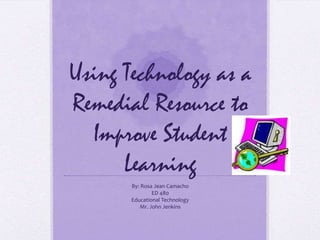/Volumes/Usb Disk/Rosaed480
- 1. Using Technology as a Remedial Resource to Improve Student LearningBy: Rosa Jean CamachoED 480Educational TechnologyMr. John Jenkins
- 2. To successfully and effectively use technology Specific educational goals and a vision of learning through technologyOngoing Professional DevelopmentStructural Changes in the school dayA robust technical infrastructure and technical supportOngoing Evaluation
- 3. Educational Goals need to be determined...What do students need to learn and how can technology promote those learning goals?The school can convene a technology planning team comprised of administrators, teachers, technology coordinators, parents, students, etc.. To develop a clear set of goals and then determine which types of technology best support efforts to meet the goals.
- 4. Professional DevelopmentProfessional Development to teachers to help them choose the most effective and appropriate strategies. Teachers need to be supported in their efforts to use technology.Students can not benefit if the teacher is neither comfortable nor familiar with it.
- 5. Changes in the School DayIt is important to build time into the daily schedule allowing teachers time to collaborate and work with their students.Longer class periods and more allowance for team teaching and interdisciplinary work.Example: students need more than 30-40 minute periods to find, explore, and synthesize these materials (artwork, data sets, historical documents) for their research.Problem will no longer be not enough computers but not enough time
- 6. Teachers must have access to on-site technical support personnel who are responsible for troubleshooting and assistance after the technology and lessons are in place. School districts have a responsibility to create not only nominal access to computers and electronic networks but access that is robust enough to support the kinds of use that can make a difference in the classroom.
- 7. EvaluationOngoing evaluation of technology applications and student achievement based on the overall educational goals that were decided on.Ensure that technology is appropriate, adaptable, and useful. Such evaluation also facilitates change if learning goals are not being met.
- 8. How technology can reach out to all Multiple IntelligencesVerbal/Linguistic IntelligenceComputer software: allows them to write and illustrate their own stories before fine motor skills are developed enough to allow them by hand.Word processing software: stimulates learners to interact more closely with their work.Audio and video recording can give students instant feedback on story-telling skills.
- 9. Logical-Mathematical Multimedia products that graphically illustrate physics concepts.Providing challenging visual/spatial tasks which develop mathematical and logical thinkingDevelop higher-order mathematical thinking by making abstract ideas concrete
- 10. Visual-SpatialâPaint programs allow students who are unskilled with paper and brush create art on computer screensDatabases of art workDesktop publishingCamcorders to create documentariesInternet links to museums and virtual tours
- 11. Bodily KinestheticEducational games which challenge fine motor coordination while developing logical thinking skills and mastery over abstractions.Construction of lego robots and program their movement through the computerElectronic fieldtrips allow students to interact electronically with a scientist who is exploring the depth of the meditteranean sea.
- 12. Musical Intelligence Students can hum into a synthesizer and make it sound like any instrument they wantMusical Instrument Digital Interface (MIDI) makes it possible to make music on an electronic keyboard which can be made to sound like any instrument and then can be orchestrated electronicallyListening to renowned classical music which tells about a composerâs background.
- 13. Interpersonal Electronic networks linking students with their peers within the community and around the worldLumaphones allow students to see a picture of the person with whom they are speaking.
- 14. IntrapersonalMultimedia gives teachers the tools to turn the classroom into centers of student-directed inquiryTechnology offers tools for thinking more deeply, pursuing curiosity, and exploring and expanding intelligence as students build âmental modelsâ with which they can visualize connections between ideas on any topic.Multimedia portfolios, videotaped interviews, electronic records, etcâĶ
- 15. Technology tools in the classroomElmoDigital CamerasSmartboardTalking CalculatorsBoard makerDigital Textbooks















